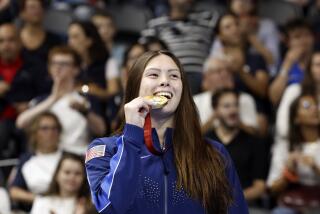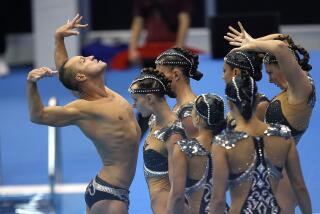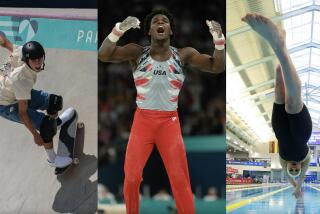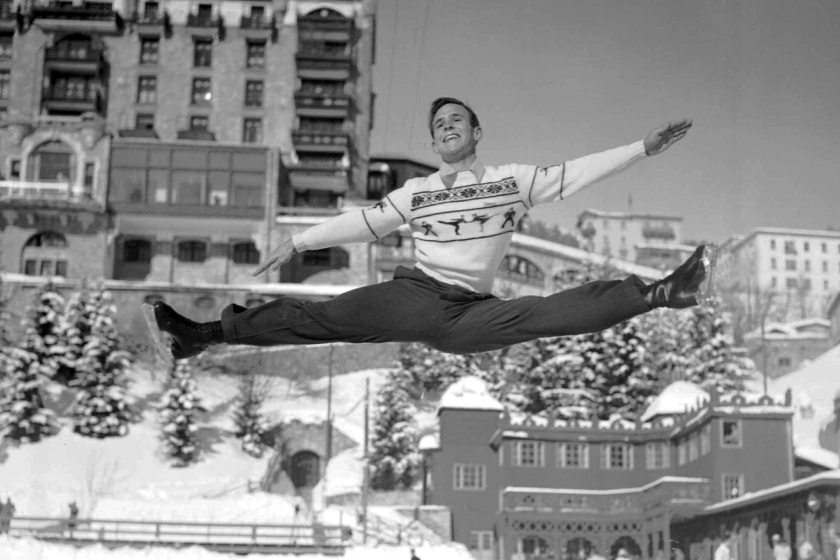U.S. Swim Trials Are Popular Down Under
- Share via
All eyes will not be on Indianapolis this week--all things considered, all eyes are never on Indianapolis--but across the Pacific and a left turn down under, a few dozen elite swimmers and a few million aquatics fanatics will be monitoring results and electronic clockings from the Indiana Natatorium.
From the American perspective, the eight-day U.S. Olympic swim trials, which begin Wednesday, are a perfunctory exercise, the requisite qualifying meet before the interesting stuff in Sydney in September.
From the Australian perspective, the enemy is about to assemble its starting lineup for the dual meet of the century.
Track and field may be the traditional mainstay of the Summer Olympics, but to the hosts of these Olympics, Marion Jones is but a sideshow because Jones does her 100-meter sprinting outside the pool. Competitive swimming is a national obsession in Australia--and unlike track or gymnastics or boxing or soccer, Australia is a power in international swimming, ready this year with a swim team hailed as the best the country has ever produced.
This current Aussie swim team owns five world records--Ian Thorpe in the men’s 200- and 400-meter freestyle, Michael Klim in the men’s 100 butterfly, Susie O’Neill in the women’s 200 butterfly and Kieren Perkins in the men’s 1,500 freestyle--with teammates Grant Hackett, Matt Welsh, Matthew Dunn and Petria Thomas among the world leaders in their respective events.
But the United States remains the Murderer’s Row of world swimming and the Aussies have been awaiting the arrival of Team USA on their pool deck since, oh, the day they were voted the 2000 Games in 1993.
Girding for what they are already touting as The Wet War, Australians will be tuned in to the U.S. trials, zeroing in on these events in particular:
* Men’s 100 freestyle: Neil Walker has finished second to Klim at the 1997 and 1999 Pan Pacific Championships and this year, at the U.S. Spring Nationals, reeled off the third-fastest American time ever-- 49.02 seconds--behind only world-record holder Matt Biondi and Gary Hall Jr.
* Men’s 200 freestyle: Thorpe and Klim have qualified for Australia, now awaiting what challengers the United States will throw into the pool with them. The top two finishers in each individual event at the U.S. trials qualify for the Olympics and that most likely means Josh Davis, who threatened Biondi’s 12-year-old American record at the Spring Nationals, and three-time U.S. champion Chad Carvin.
* Men’s 400 freestyle: Thorpe rules these waters, having lowered his world record at the Australian Olympic trials this spring to 3 minutes 41.33 seconds. Carvin and Tom Dolan are the only Americans to have broken 3:50 during the last three years.
* Men’s 100 backstroke: Studio City’s Lenny Krayzelburg, with world records at 100 and 200 meters, is favored for a backstroke sweep in Sydney. His 1999 100-meter mark of 53.60 seconds is nearly a full second better than his chief American rivals, Walker and Irvine’s Aaron Peirsol. Australia has two medal contenders in this event--Welsh, who swam 54.14 at the trials, and Josh Watson.
* Men’s 200 individual medley: Australia’s Dunn owns the world’s best time of the last two years--2:00.26 at the 1998 Commonwealth Games. The U.S. trials will feature three of the 10 fastest men ever in this event--Dolan, Tom Wilkens and Ron Karnaugh--but only two will make it to Sydney.
* Women’s 100 freestyle: The most overcrowded event at the trials, featuring the four fastest American women ever at this distance--Jenny Thompson, Dara Torres, Angel Martino and Amy Van Dyken. Only two will qualify for this event at the Olympics, but on the other hand, that U.S. 400 relay team ought to be something.
* Women’s 100 breaststroke: So what’s up with Amanda Beard? The Aussies know Beard finished second twice to South Africa’s world-record holder Penny Heyns at the 1996 Olympics, but haven’t heard much of her since. After quitting the sport and then regrouping with the University of Arizona swim team, Beard is on the comeback path, but Indianapolis is looking like her final destination for 2000. Megan Quann, who set the U.S. record this spring, and Kristy Kowal are heavy favorites here.
* Women’s 100 butterfly: Mary T. Meagher owned world records in the 100- and 200-meter butterfly for nearly two decades before Thompson and O’Neill picked them off, one by one, during the last 12 months. Thompson got the 100-meter record (57.88) at the 1999 Pan Pacifics, O’Neill the 200 mark at this year’s Australian Olympic trials. With Thompson sitting out the 200 butterfly, the 100 butterfly will serve as the official Olympic showdown between O’Neill and Thompson.
SYDNEY? SEE YOU LATER
While American swimmers will be churning and burning in Indianapolis, scrambling for berths on the Olympic team, other athletes in other sports are handing back their free passes to the Sydney Games.
Pete Sampras and Anna Kournikova turned down invitations to the Olympic tennis competition, determining in advance that they are either too big or will be too tired for a tournament set to begin less than two weeks after the U.S. Open.
Likewise, Vlade Divac has said no to the Yugoslav national basketball team and Tim Duncan has informed USA Basketball officials that he wants out of the Olympics. Reasons given: With a grind of NBA training camps awaiting in early October, they need their rest.
So this then is Avery Brundage’s revenge.
Professionalism, finally, is ruining the Olympics.
Brundage, who defended the amateurs-only Olympian edict with an iron fist during his years as International Olympic Committee president, never would have foreseen this: Pros, having been given the long-fought right to participate in the Olympic Games, now are saying they can’t be bothered.
Sure, this year’s late start to the Olympics will push the basketball tournament up against the start of training camp, and, yes, Duncan is coming off knee surgery, but what exactly are the demands of this assignment?
To spend a week or so in Hawaii--USA Basketball is classifying this island holiday as “Pre-Olympic Training Camp”-- and then fly down to Sydney to grab a few rebounds, hit a few bank shots and collect the gold medal. Yes, it’s going to be exhausting, standing up there all the way through “The Star-Spangled Banner.”
Kournikova? Russian federation officials are in a dither over their diva’s decision to not do Sydney, but, really, what’s the big deal? The Olympics are just one more tournament Kournikova won’t win.
Sampras’ bypass is less of a surprise-- he never planned to compete in Sydney-- but is no less troubling. Famously indifferent about competing for his country in Davis Cup, Sampras has only taken the chisel a little deeper to his I’m-only-in-it-for-me reputation. Sampras has his reasons for not playing Sydney, one or two of them even legitimate, but after winning his record 13th Grand Slam title at Wimbledon, the message he continues to project is: I got mine, the rest of you are on your own.
“To have Davis Cup and the Olympics in the same year,” Sampras said last week at a tournament in Toronto, “you’re going to see a lot of guys burnt out at the end of the year.”
Not Sampras, though. The only Davis Cup appearance he made this year was in his hometown, Los Angeles--he skipped the road swings through Zimbabwe and Spain--and he won’t be boarding the shuttle to Sydney. A Laker season-ticket holder, Sampras, too, needs to be rested for the start of NBA training camp.
TEAM TENNIS, ANYONE?
Sampras does make one salient point when rationalizing his Olympic no-show.
“It’s a 128-player draw. We play that all year around,” Sampras says. “If we have more of a team concept, like the World Team Cup, that’s more the Olympic spirit.”
In other words, the Olympic tennis competition, as presently constructed, is nothing special. Just another out-of-the-way tour stop, with a pitifully small winner’s purse. How much does a gold medal go for these days, anyway?
A team-tennis format, however, would make the Olympics unique. And more attractive to players who spend 99% of their careers playing for me, myself and I, and find the four annual stages of the Davis Cup too much of an individual hassle.
Potential formats:
1. Davis Cup/Fed Cup style. Men’s and women’s national teams competing, each round, in four singles matches and one doubles match.
2. Scholastic dual match style. Men’s and women’s national teams competing in four-to-six singles flights and two-to-three doubles flights.
3. Team Tennis style. The best suggestion yet--throwing men and women together on the same teams, the way Billie Jean King mapped it out for her Team Tennis leagues a quarter-century ago. How about this U.S. starting lineup: Sampras or Andre Agassi in men’s singles, Lindsay Davenport in women’s singles, Alex O’Brien and Jared Palmer in men’s doubles, Venus and Serena Williams in women’s doubles and Palmer and pick-a-Williams in mixed doubles.
It’s something to consider before Athens 2004, which, incidentally, Sampras has not ruled out playing.
“I know the next one’s in Athens and, being a Greek, that’s a possibility,” Sampras says.
Except it will be scheduled right before the U.S. Open.
And it will be played on clay.
How about 2008, then?
More to Read
Go beyond the scoreboard
Get the latest on L.A.'s teams in the daily Sports Report newsletter.
You may occasionally receive promotional content from the Los Angeles Times.






